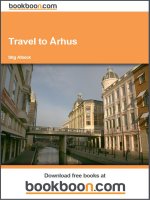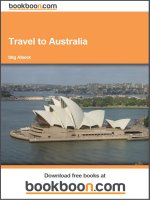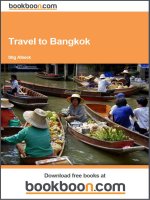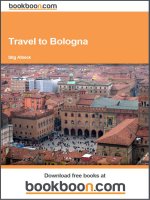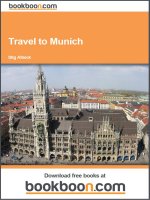Travel to Japan & South Korea pot
Bạn đang xem bản rút gọn của tài liệu. Xem và tải ngay bản đầy đủ của tài liệu tại đây (7.26 MB, 91 trang )
Download free ebooks at bookboon.com
Download free ebooks at bookboon.com
Japan & South Korea
© 2008 Stig Albeck & Ventus Publishing ApS
Translation: Karen Rosen
All rights and copyright relating to the content of this
book are the property of Ventus Publishing ApS, and/or its
suppliers. Content from ths book, may not be reproduced
in any shape or form without prior written permission from
Ventus Publishing ApS.
Quoting this book is allowed when clear references are made,
in relation to reviews are allowed.
ISBN 978-87-7061-328-6
1st edition
Pictures and illustrations in this book are reproduced according
to agreement with the following copyright owners
Eugene Park, Korean Tourism, Stig Albeck, Brian McMorrow,
Eva Lis Petersen, Tokyo Convention & Visitors Bureau.
The stated prices and opening hours are indicative and may
have been subject to change after this book was published.
Download free ebooks at bookboon.com
Japan & South Korea
4
Kapiteloverskrift ONLIBRI
Download free ebooks at bookboon.com
Japan & South Korea
5
A visit to Seoul
www.visitseoul.net
www.knto.or.kr
www.tour2korea.com
In Seoul you meet the beautiful ancient Korean
culture, but at the same time you really feel that
you're in one of Asia's modern metropolises.
The capital of Southern Korea has many palaces
surrounded by green parks, and you can sense the
serenity and balance of the beautiful buildings.
Seoul is endowed with many natural features; the
river, that flows calmly through the city and the
hills that both surround and form part of the city.
Overlooking it all is the Seoul Tower from which
you get a good idea of the size of the city and the
contrast between the modern architecture and the
historical palaces.
When the day turns into night there's a lot to do in
the city that lacks nothing in the fields of shopping,
eating, and sightseeing. Indoor fun parks like Lotte
World are very popular.
Seoul is situated close to its sister country North
Korea and if you can, you should take a trip to
The Demilitarized Zone, where you not only
come close to the country to the north but actually
enter North Korean territory.
Have a nice journey!
A visit to Seoul
Download free ebooks at bookboon.com
Japan & South Korea
6
Historical outline
The first settlements in Seoul can through
archaeological findings be dated back more than
6,000 years. Back then there was an agricultural
settlement in the fertile area along the river Han.
Seoul became the capital of Korea at the time of
the kingdom of Paekche which began in 57 BC.
Seoul is simply the Korean word for capital. Until
668 it was the era of The Three Kingdoms. In
addition to Paekche there were the Kingdoms of
Koguryo and Shilla.
In 668 the kingdom of Shilla conquered the other
two, and also Seoul which they renamed Hansong.
After the unification of Korea during the Dynasty
of Koryo, which reigned from 918, the city was yet
again renamed; this time it was called Yangju, but
the name was changed again to Namgyong – the
southern capital – in 1067. At that time it was one
of three major cities in Korea.
It also became the starting point for the
development of the Seoul we know today. Until
then it had been a small town, primarily agricultural,
but when king Munjong in 1068 had a summer
palace built in Seoul, other groups of people went
to live there as well. That was the beginning of the
city's transformation toward the important city
Seoul is today.
In 1392 the Dynasty of Chosun came to power,
and the city was called Hanyang. The king Yi Song-
Gye organised a thorough investigation into where
the best place for at united capital would be, if it
was to be able to develop as well as be defendable.
The result was, after two years of investigating, that
Hanyang formally became the capital of the whole
of Korea and King Yi Song-Gye began to move his
administration and Court here.
That was the beginning of an era of many building
projects, including palaces and government
buildings. The palace of Kyongbuk was built, and
it remained the kings' residence through several
centuries. The city wall, which is 17 km long, was
also built. It took no more than 98 days for almost
200.000 workers to build it.
During the reign of the Chosun Dynasty, Korea
was almost isolated from the rest of the world.
The biggest opening was toward the neighbours in
China, and for centuries Chinese culture had a
great influence on the Korean.
In the beginning of the 18th century the
population of the city was about 200,000. That
number remained stable through the following
two centuries primarily because of the isolationist
policy toward the rest of the world, which meant
that Korea wasn't influenced by an increase in
trading. 1876 became the year Korea opened up
for diplomatic connexions to the western
countries. This created a new period of growth
based on trade, production, and foreign
representations.
The open Korea became a part of the Japanese
Empire in 1910. The city remained the
administrative centre of the Korean peninsula, but
changed its name again; this time it was called
Kyonsong. The development did not stop with
the Japanese control, and in the mid 30ies the
number of inhabitants had risen to 750,000. The
Japanese control ended along with World War 2,
and the new and independent Korea became a
reality. On august 15
th
the city was given its
current name, Seoul.
In the years succeeding the independence of
Korea the capital developed rapidly and in 1949
Seoul became home to several new administrative
branches. The city's population had grown to over
1,400,000.
Shortly hereafter came the Korean War that
devastated Seoul, and the city had to be almost
entirely rebuilt. Before the war ended in 1953
Historical outline
Download free ebooks at bookboon.com
Japan & South Korea
7
Seoul had been conquered and reclaimed numerous
times, and each time there was severe fighting in
the streets.
Seoul remained capital after the war, but now only
of South Korea (Pyongyang became the capital of
North Korea). Through the 1950ies and 1960ies a
colossal amount of reconstruction work took place
with the participation of the entire population and
a special law that enabled the prime minister to take
immediate action and responsibility for the
progress.
During this period the area of the city was
immensely expanded. The old city in the northern
traditional centre of Seoul has grown with the
great modern areas along the river Han including
blocks of flats, entertainment and shopping
centres for the 10 millions and more inhabitants of
today.
The success of the new South Korea really came
to the attention of the whole world with the huge
sports event Asian Games in 1986 and the
Olympic Games two years later. More recently,
South Korea and Japan hosted (the) World
Championships in football in 2002.
Historical outline
Download free ebooks at bookboon.com
Please click the advert
Japan & South Korea
8
Tour 1: Seoul
1. The Palace of Changgyeonggung/
ᯠᝊᆂ 㺓ἓῗ
2-1 Waryong-dong, Jongno-gu
Metro: Haehwa
The palace of Changgyeonggung was built by
King Sejong as a residence for his father Taejong.
The palace was renovated and expanded in 1483
by King Seongjong to become residence for
Queen Dowagers.
The central part, the Myeongjeon building, was
built in the 14
th
century. That makes it the oldest
of its kind in Korea. The building burned down in
1592, but it was rebuilt in 1616.
The park that surrounds the palace is very
beautiful and here lies the Chundangji Lake that
used to be a rice field. The king cultivated the rice
himself to better understand the ways of life of the
rural population. The park was changed in 1909
when the Japanese turned it into a botanical
garden and a zoo (both were moved in 1983).
Tour 1: Seoul
Download free ebooks at bookboon.com
Japan & South Korea
9
2. The Palace of Changdeokgung/
ᯠᖋᆂ 㺓▫ῗ
2-71 Waryong-dong, Jongno-gu
Metro: Anguk
The palace of Changdeokgung was built by King
Taejong in 1405 to serve as (a) royal villa. It
became the King's residence after the destruction
of the Gyeongbokgung palace in 1592.
The surroundings of the palace with its many
pavilions are characterised by rough terrain, and
here the Korean tradition for harmony between
buildings and nature is accentuated. The
architecture is very varied through the grounds, e.g.
the magnificent back yard in which the many trees
and flowers almost become fused with the
pavilions.
The huge Injeongjeon building is the throne room
of the palace, and is placed in the centre. This is
where the kings made decisions about affairs of
state and held official meetings and
representations. The throne room was last
changed under the King Sunjo in 1804.
3. The holy shrine of Jongmyo/
ᅫᒳ 㫛
1-2 Hunjeong-dong, Jongno-gu
Metro: Jongno 3-ga
Jongmyo is a royal shrine, built at the end of the
14th century, shortly after Seoul became the
capital of Korea. Four times a year the elegant and
grandiose grounds formed the background of
ceremonies in which the king, his sons and
military leaders participated. This place is
considered to be one of the most important of
Korean cultural history.
Tour 1: Seoul
Download free ebooks at bookboon.com
Japan & South Korea
10
Tour 1: Seoul
Download free ebooks at bookboon.com
Please click the advert
Japan & South Korea
11
Tour 2: Seoul
4. The palace of Gyeongbokgung/
᱃⽣ᆂ ἓ⽋ῗ
1 Sejong-ro, Jongno-gu
Metro: Gyeongbokgung
The palace of Gyeongbokgung was built in 1395
by King Taejo. The name means "shining
happiness" and the palace is a tribute to the
perpetual happiness and success of the Korean
kings.
In 1592 the palace was destroyed during the
Japanese invasion and it was in ruins until its
reconstruction in 1865. However, it wasn't
brought back to its original form until the 1990ies.
Gyeongbokgung gives the visitor a fantastic
impression of Korean cultural history of earlier
centuries, and the palace itself with the many
different buildings and gates as well as wonderful
park is a lovely place to visit.
In the park one can see the Gyeonghoeru pavilion
that virtually floats on the water of the artificial
lake surrounding the pavilion. The pavilion was
built in 1412 by King Taejong, burnt down in
1592 and reconstructed in 1867 by King Gojong.
Tour 2: Seoul
© Deloitte & Touche LLP and affiliated entities.
360°
thinking
.
Discover the truth at www.deloitte.ca/careers
© Deloitte & Touche LLP and affiliated entities.
360°
thinking
.
Discover the truth at www.deloitte.ca/careers
© Deloitte & Touche LLP and affiliated entities.
360°
thinking
.
Discover the truth at www.deloitte.ca/careers
© Deloitte & Touche LLP and affiliated entities.
360°
thinking
.
Discover the truth at www.deloitte.ca/careers
Download free ebooks at bookboon.com
Japan & South Korea
12
In the park opposite the entrance lies the
Hyangwonjeong pavilion on an island in the small
lake, into which water pours from the cold spring
that wells up north-west of the pavilion. In Korea
the number six symbolises water, and because the
pavilion is built by the lake it has the form of a
hexagon. One reaches the island and pavilion by
an elegant wooden bridge called Chwihyanggyo.
West of the palace of Gyeongbokgung lies the
Sajikdan altar which was built at the end of the 14
th
century, as was the palace. The altar was built in
honour of the gods of the earth and of good
harvest. The kings would come here several times
each year and today ceremonies still take place in
spring and autumn.
4a. Museum of cultural history/
ῃ
ῃⰓ㭧㞯ⶒὖ
On the grounds of the Gyeongbokgung palace lies
the beautiful building that houses the museum of
cultural history. It is built in white marble and has a
blue tile roof.
The museum portrays Korean life style and culture
from prehistoric times until the period of Joseon.
You can see models of pagodas and temples as well
as different exhibitions on, for example, the
creation of the Korean alphabet.
5. The Korean museum of folklore/
ῃⰓ⹒㏣ⶒὖ
1-1 Jongno-gu
www.nfm.go.kr
Metro: Gyeongbokgung
The museum lets the visitors in on everyday life in
Korea from ancient times through the Bronze Age
and up until the country became a monarchy.
Here you will find writings from the Goryeo era,
wedding artefacts, clothing, and carefully crafted
models of different Korean buildings such as the
nine storeys high Hwangnyongsa pagoda.
6. Dongnimmun/⤼ゟ䭔 ☛Ⱃⶎ
945-beonji Hyeonjeo-dong, Seodaemun-gu
Metro: Dongnimmun
The impressive gate of Dongnimmun was built in
1898 as a celebration of Korea's freedom and
independence. You find it in the Independence
Park where it stands as a monument over the
Korean people's fight for their country.
7. The temple of Bongwonsa/⽟㤦㌂
San 1, Bongwon-dong, Seodaemun-gu
www.bongwonsa.or.kr
Metro: Dongnimmun
The temple of Bongwonsa was founded in 889
during the Silla reign. However, the current temple
was built under King Yeoungjo as the original was
destroyed during war actions. The big central
building has been built without the use of nails,
which is quite unique.
Twice a month at the Bongwonsa temple, there is
a show of traditional Korean rituals and costumes.
It is an interesting show, especially because of the
beautiful setting that the Bongwonsa temple provides.
Tour 2: Seoul
Download free ebooks at bookboon.com
Japan & South Korea
13
8. The palace of Gyeonghuigung/
ἓ䧂ῗ
1-126, Sinmunno 2-ga, Jongno-gu
Metro: Seodaemun
The palace of Gyeonghuigung was finished in 1620
and comprised more than 100 buildings and rooms.
It was used as an annex to the royal residential
palace, Changdeokgung.
Two great fires in the 19
th
century ruined most of
the buildings. The remains were torn down
during the Japanese occupation. In the 1980ies a
restoration of the area began, and the Sungjeongjeon
building from 1985 is particularly impressive.
9. The museum of city history in
Seoul/㍲㤎㡃㌂ⶒὖ
2-1 Sinmunno 2-ga, Jongnu-gu
www.museum.seoul.kr
Metro: Seodaemun
This museum describes the development of Seoul
from 5,000 BC, both the geographical urbanisation of
the area and the lives of the city's inhabitants.
The museum is divided into different themes –
how Seoul became the capital of Korea, the
development of living conditions during the
Joseon Dynasty and the royal traditions of Seoul,
among other things. Of the many beautiful
historic objects in the museum, the majority is
from the Joseon era.
Tour 2: Seoul
Download free ebooks at bookboon.com
Please click the advert
Japan & South Korea
14
Tour 3: Seoul
10. King Sejong's Memorial Hall/
㎎㫛╖㢫₆⎦ὖ
San 1-157, Cheongnyangni-dong,
Dongdaemun-gu
Metro: Cheongnyangni
The Memorial Hall was founded in 1970 as a
tribute to King Sejong's achievements, not least the
creation of the Korean alphabet, Hangeul.
11. The holy shrine of Dongmyo/
☯ὖ㢫
238-2, Sungin-dong, Jongno-gu
Metro: Dongmyo
The holy shrine of Dongmyo was built to honour
the historical Chinese military leader Guanyu. The
place was made during the reign of King Seonjo at
the end of the 16
th
century. The king had it made
because he feared a Japanese invasion. In a vision
he saw Guanyu and was told that his spirit would
defend Korea as a united country.
Tour 3: Seoul
Increase your impact with MSM Executive Education
For more information, visit www.msm.nl or contact us at +31 43 38 70 808
or via
the globally networked management school
For more information, visit www.msm.nl or contact us at +31 43 38 70 808 or via
For almost 60 years Maastricht School of Management has been enhancing the management capacity
of professionals and organizations around the world through state-of-the-art management education.
Our broad range of Open Enrollment Executive Programs offers you a unique interactive, stimulating and
multicultural learning experience.
Be prepared for tomorrow’s management challenges and apply today.
Executive Education-170x115-B2.indd 1 18-08-11 15:13
Download free ebooks at bookboon.com
Japan & South Korea
15
When the Japanese invasion came in 1592 many
places and buildings in Korea were destroyed, but
the country held out and remained united. Many
years after the fights Guanyu was honoured with
celebrations for the help his spirit had given Korea.
At the back of the grounds there is a statue of
Guanyu; the red face being his own and the yellow
that of his spirit.
12. The gate of Heung-injimun/☯╖ⶎ
Jongno 6-ga, Jongno-gu
Metro: Dongdaemun
The mighty gate of Heung-injimun (a.k.a. gate of
Dongdaemun) is the eastern main entrance to
Seoul. The gate was built in 1398, but has later
been changed, most recently in 1869.
At the foot of the gate is the special wall built in a
semicircle to trap potential attackers. The base of
the gate is made of granite and the great pavilion
that constitutes the gateway is made of wood and is
typical of the Joseon Dynasty in its design and
ornamentation.
13. Supyo Bridge/㑮䚲ᾦ
197-1, Jangchung-dong 2-ga, Jung-gu
Metro: Dongguk University
Supyo Bridge was built by King Sejong in 1420. It
used to be in another part of the city, but was
moved in 1958 to make room for the developing
infrastructure. The stone banister is very
decorative, and the water levels are marked in
Chinese characters.
14. Korea's National Theatre/ῃⰓ⁏㧻
San 14-67, Jangchung-dong, Jung-gu
www.ntok.go.kr
Metro: Dongguk University
Korea's National Theatre was built in 1973. It is a
modern structure visibly inspired by traditional
Korean architecture. The theatre has three stages –
one large, one small and one outdoors, and
traditional plays, dance shows, ballets and operas
are performed here.
Tour 3: Seoul
Download free ebooks at bookboon.com
Japan & South Korea
16
15. Seoul Tower/㍲㤎䌖㤢
Yongsan-dong 2-ga San 1-3, Yongsan-gu
www.seoultower.co.kr
Metro: Myeong-dong
Seoul Tower was built in the years 1969-1975 on
the peak of the Namsan Mountain. The base of the
tower is built at 243 metres above sea level and the
tower itself is another 236,7 meters high. In the
tower you will find an observation deck from
which there is a breathtaking view of the city and
its neighbouring areas.
The tower also houses two restaurants that rotate
360Ü in one hour. Especially at sunset dining here is
an interesting and beautiful experience.
There are many ways of getting to the Seoul Tower
e.g. by aerial cableway. However, walking to the
peak of the Namsan Mountain is recommendable
because of the varied flora and many vantage
points you pass on the way up.
16. The altar of Won-gudan/㤦ῂ┾
87-14, Sogong-dong, Jung-gu
Metro: Euljiro
The incredibly beautiful temple-like altar in the
garden of the Chosun Hotel is where King
Gojong proclaimed himself emperor. That was the
beginning of the Daehanjeguk Empire and the end
of the Joseon Dynasty. The garden used to be
bigger but was destroyed during the Japanese
occupation.
17. Deoksugung Palace/ᖋ໑ᆂ
▫㑮ῗ
5-1 Jeong-dong, Jung-gu
Metro: City Hall
Deoksugung Palace used to be residence of King
Seongjong's brother, prince Wolsandaegun.
However, approximately 100 years later, in 1593,
King Seonjo came to live here temporarily.
Seonjo's successor on the throne, Gwanghaegun,
moved permanently into the Changdeokgung
Palace in 1615 which ended the political role of
the Deoksugung Palace until 1897 when King
Gojong moved here.
The great Junghwajeon throne room was rebuilt
after a fire in 1904. The dragon on the ceiling is a
symbol of King Gojongs authority – which he
underlined by calling himself emperor.
The Seokjojeon building is Korea's first
renaissance building; it was built in 1936-1938 and
is visibly inspired by the 19
th
century's colonial
Tour 3: Seoul
Download free ebooks at bookboon.com
Please click the advert
Japan & South Korea
17
style. It has both residential areas and audience
rooms. Today the two wings of the building have
been converted into museums. The east wing is a
part of the Royal Museum while the west wing
exhibits modern Korean art – e.g. quite a few of
the National Museum’s art collections.
18. Seungnyemun Gate/⋾╖ⶎ
29 Namdaemun-ro 4-ga, Jung-gu
Metro: Seoul Station/City Hall
The Seungnyemun Gate (also called Namdaemun)
is one of Korea's most important buildings. The
gate was built in 1396-1398 and is the largest gate
ever built in Korea. It was the noblest entrance to
the city and all representatives from, for example,
China and Japan were to go through here before
arriving in Seoul – therefore, it is of great
importance to the Koreans. The gate is especially
beautiful at night because of its illumination; the
roof virtually shines over the big city.
There used to be a wall of defence around the gate
but it was torn down during the Japanese reign of
Korea.
Tour 3: Seoul
Get “Bookboon’s Free Media Advice”
See the light!
The sooner you realize we are right,
the sooner your life will get better!
A bit over the top? Yes we know!
We are just that sure that we can make your
media activities more effective.
Download free ebooks at bookboon.com
Japan & South Korea
18
Tour 3: Seoul
Download free ebooks at bookboon.com
Japan & South Korea
19
Tour 4: Seoul
19. The National Museum/
ῃⰓ㭧㞯ⶒὖ
168-6 6-ga, Yongsan-dong, Yongsan-gu
www.museum.go.kr
Metro: Ichon
Korea's National Museum has 18 permanent
exhibitions which all relate to the country's history.
More than 5,000 objects are on display – from
archaeological findings from ancient times to things
relating to the birth of modern Korea. The
museum is also a cultural research and mediation
centre of traditional Korean culture.
20. Yeouido Park/㡂㦮☚Ὃ㤦
Yeouido-dong 2, Yeongdeungpo-gu
Metro: Yeouido
On Yeouido Island in the river Han used to be an
airfield. It has now been replaced by modern
government and business buildings and the
beautiful Yeouido Park. The surrounding
buildings make up an impressive sight from the
park. They constitute one of the world's most
modern financial centres. At the same time you
can see the lakes and pavilions of the park that are
built in traditional Korean style.
21. KLI63 Building/63 ア❿
Yeouido-dong, Yeongdeungpo-gu
www.63city.co.kr
Metro: Yeouinaru
On the southern bank of the Han River by
Yeouido Island thrones the KLI63 skyscraper – it
has 3 subterranean levels, and its 60 storeys,
measuring almost 400 meters, makes it the tallest
building in Korea. The shiny golden edifice houses
an aquarium in two of the lower storeys as well as
an IMAX cinema, and from the observation deck
on the top floor there is an amazing view of the
Korean capital.
Tour 4: Seoul
Download free ebooks at bookboon.com
Japan & South Korea
20
22. The Bongeunsa Temple/
༝ᘽᇎ ⽟㦖㌂
Samseong-dong 73, Gangnam-gu
Metro: Samseong
The Buddhist monk Yeonhoeguksa began
building the Bongeunsa Temple, originally called
the Gyeonseongsa, in 794. The name was changed
in connexion with a major expansion in 1498. On
the temple grounds lies the Seonbuldang building,
a wooden construction on which a plaque hangs
with calligraphy by the great master Kim Jeonghee.
Tour 4: Seoul
Download free ebooks at bookboon.com
Please click the advert
Japan & South Korea
21
Day Tours from Seoul
23. Seoul Olympic Museum/
㢂Ⱂ䞓Ὃ㤦ὒ
Bang-i-dong 88, Songpa-gu
www.seoulolympicmuseum.com
Metro: Mongchontoseong/Olympic Park
Seoul hosted the Olympic Games in 1988 and in
the city's Olympic Museum you can see Olympic
highlights again and get a picture of the influence
they have had on Seoul and Korea. There is also
an exciting exhibit about the Olympic Games'
history that stretches more than 100 years back.
The museum can be found in the Olympic city,
not far from the stadium where the games took
place.
Day Tours from Seoul
GO T -THE-ENER GY -TO-LEAD.COM
We believe that energy suppliers should be renewable, too. We are therefore looking for enthusiastic
new colleagues with plenty of ideas who want to join RWE in changing the world. Visit us online to find
out what we are offering and how we are working together to ensure the energy of the future.
Download free ebooks at bookboon.com
Japan & South Korea
22
24. The Demilitarized Zone/DMZ
50 km N
www.korea-dmz.com
Korea has been split between North and South
Korea. After the Korean War, the Demilitarized
Zone / DMZ was established. The zone crosses
the entire country from east to west and stretches
over 2 km on either side of the actual border. DMZ
is a very firm symbol of the Cold War that marked
the world after World War 2. Today the zone is a
fascinating blend of excitement and peace.
You should visit the DMZ on an arranged trip
because of the general formalities of getting into
and out of the area and in connexion with some of
the specific sights.
24a. Imjingak/㧚
㧚㰚ṗ
1325-1 Majeong-ri, Munsan-eup, Paju-si, 54 km
NW
Station: Imjingak
Imjingak, which lies 7 km from the DMZ, is the
centre of tourist information about the Korean
issue. The area of Imjingak was built in 1972 and it
comprises a memorial park, various monuments, a
North Korean centre and the Imjingak building
itself.
Here you can see various (typical) objects from the
Korean conflict, e.g. tanks. You can also see the
Gyeongui Railroad, which was destroyed in 1950.
24b. The Third Tunnel/
䎆⍦
Jeomwon-ri, Gunnae-myeon, Paju-si, 58 km
NW
The Third Tunnel was discovered in 1978. The
tunnel leads from South to North Korea and the
discovery raised speculations on either side as to
whether it was made for a possible invasion. The
tunnel is built so as to let approximately 10.000
soldiers through in one hour. Close to the tunnel
is the Mt. Dorasan Observation Platform from
which you can overlook the area and also see into
North Korea. Imjingak is a good place to start
from if you wish to see these places.
24c. Panmunjeom/
䕦ⶎ㩦
Eoryong-ri, Jinseo-myeon, Paju-si, 70 km NV
Panmunjeom lies in the Joint Security Area in the
DMZ. Panmunjeom consists of several former
administrative buildings and is now the only place
where South and North Koreans can meet. In
1951 peace negotiations were held in these
buildings and the Red Cross held an international
conference here in 1971.
As a tourist it is possible to come from South
Korea into North Korean territory. There is a list
of specific rules that apply and you should be
aware that it is only possible on arranged trips.
Remember your passport and to ask about special
requirements regarding clothing, for example.
Day Tours from Seoul
Download free ebooks at bookboon.com
Japan & South Korea
23
25. Suwon Hwaseong/㑮㤦 䢪㎇
Jangan-gu, Gwonseon-gu, 50 km S
Station: Suwon
The impressive fortress of Hwaseong was built in
1794-1796, during the last part of the Joseon
Period. The walls of the fortress are 5,5 km long
and have four gates; the North Gate, Janganmun,
the South Gate, Paldalmun, the East Gate,
Changryongmun and the West Gate, Hwaseomun.
The fortress has numerous defence systems and
buildings, e.g. mighty towers. However, it has been
under attack many times, and part of the walls and
other constructions are destroyed. In the latter half
of the 1970ies most of Hwaseong has been
restored, though, and is today a fascinating image
of the fortress building of the period.
26. The Graves of
Donggureung/☯ῂ⯟G
Inchang-dong 62, Guri-si, 10 km E
Metro: Cheongnyangni
In a beautiful forest lie 17 graves from the Joseon
Period of which nine are proper mausoleums.
Among them you find the mausoleum of King
Taejo, who founded the Joseon Dynasty and ruled
from 1335 to 1408. Taejo's mausoleum is called
Geonwonneung.
The area is so beautiful that just taking a walk
amongst the mausoleums is part of the experience.
It has plants brought here by King Taejo, thus
having witnessed 600 years of Korean history.
Day Tours from Seoul
Download free ebooks at bookboon.com
Please click the advert
Japan & South Korea
24
27. Suwon Namhansanseong/
⋾䞲㌆㎇
Jungbu-myeon, Gwangju-si, 30 km SW
Station: Sanseong
The fortress of Namhansanseong is situated high
in the Namhansan Mountains outside of Seoul.
The mountains are known for their beauty in all
seasons – and in addition to the beauty of the
place, is has a wonderful view of Seoul and the
surrounding Gyeonggi area from the highest peak,
Iljangsan.
The fortress itself was first built about 2000 years
ago. However, the present one is from the Joseon
Period and was built in 1621. A walk along the
fortress walls and in the inner and outer courtyard
is both beautiful and interesting.
Day Tours from Seoul
Contact us to hear more
Who is your target group?
And how can we reach them?
At Bookboon, you can segment the exact right
audience for your advertising campaign.
Our eBooks offer in-book advertising spot to reach
the right candidate.
Download free ebooks at bookboon.com
Japan & South Korea
25
28. Achim Goyo Arboreturm/㞚䂾ἶ㣪
㤦㡞㑮⳿㤦
San-255, Hanghyeon-ri, Sang-myeon,
Gapyeong-gun, 30 km NE
www.morningcalm.co.kr
Station: Cheongpyeong
Achim Goyo Arboretum is also called The Garden
of Morning Calm. The arboretum was laid out in
1996 by the garden professor Han Sang-Kyeong
who wanted to create a unique garden according to
a perfect Korean pattern.
The garden has 10 theme gardens and more than
1000 different plants. There is the typical Korean
garden, the wild flowers garden, the sculptural
garden, Bunjae, and perhaps the most popular, the
Hagyeong garden with its observation tower from
which you can see the entire beautiful arboretum.
Day Tours from Seoul
